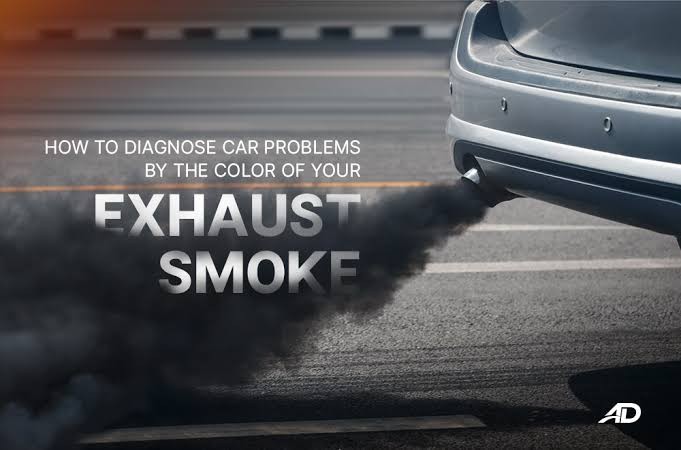The average driver will spend over 17,600 hours behind the wheel during their lifetime, yet most will ignore one of the most telling signs of engine trouble, exhaust smoke.
That plume coming from your tailpipe isn't just unsightly; it's your vehicle's distress signal.
I've spent 25 years diagnosing engine problems, and I can tell you this: exhaust smoke is like a diagnostic fingerprint. Each color tells a specific story about what's happening inside your engine. Let's decode these signals together and potentially save you thousands in repair costs.
White Exhaust Smoke
We've all seen it. That wispy white vapor on cold mornings is typically just water vapor, normal condensation from the exhaust system. But when does "normal" become a problem?
- Light, Thin White Smoke: Disappears quickly as the engine warms up? Don't worry. This is simply water vapor condensation, especially common in colder weather. Your engine is fine.
- Thick, Continuous White Smoke: This is where concern is warranted. Thick white smoke that doesn't dissipate suggests coolant is entering the combustion chamber, a classic symptom of a blown head gasket, cracked cylinder head, or even a cracked engine block.
The diagnostic approach I recommend:
- Check your coolant level first. Is it mysteriously disappearing?
- Examine the smoke's smell. Coolant often has a sweet, distinctive odor.
- Monitor your engine temperature. Overheating often accompanies coolant-related issues.
According to a study from the National Institute for Automotive Service Excellence (ASE), around 65% of thick white smoke cases are related to head gasket failures, while the remaining instances typically involve cracked cylinder heads or blocks.
Blue/Gray Smoke
Blue smoke means one thing: oil is burning somewhere in your engine. But where? The color intensity offers clues.
- Light Blue/Gray Smoke on Startup: When you see this pattern, smoke on startup that clears after a few minutes, you're likely dealing with worn valve stem seals. These small rubber components prevent oil from seeping down into the combustion chamber when the engine is off.
- Consistent Blue Smoke During Acceleration: If acceleration produces blue smoke, particularly after engine braking, worn piston rings are the likely culprit. As rings wear, they no longer seal properly, allowing oil to slip past the pistons into the combustion chamber.
A European study of vehicles with oil consumption issues found that 42% showed significant wear in piston rings, while 31% had valve seal problems. The remaining cases involved more serious issues like damaged cylinder walls or turbocharger failures.
The Impact on Your Engine
Don't ignore blue smoke! Oil consumption leads to:
- Carbon buildup on valves and pistons
- Reduced engine efficiency
- Potential catalytic converter damage
- Accelerated wear on remaining engine components
My professional recommendation: If you're consuming more than one quart of oil per 1,000 miles, it's time for a compression test and leakdown test to pinpoint the exact cause.
Black Exhaust Smoke
Black smoke indicates one fundamental issue: your engine is running rich (too much fuel, not enough air). The question is why.
Common Causes of Black Smoke
| Cause | Symptoms | DIY Check |
| Damaged MAF sensor | Stalling, hesitation | Inspect for contamination |
| Failed oxygen sensor | Check engine light, poor economy | OBD-II scanner reading |
| Malfunctioning fuel injector(s) | Rough idle, hesitation | Fuel pressure test |
| Clogged air filter | Reduced power, poor mileage | Visual inspection |
A clogged air filter alone can reduce fuel economy by up to 10%, while failed oxygen sensors can decrease efficiency by up to 40%, according to research from the Department of Energy's Vehicle Technologies Office.
Testing Before Replacing
Before replacing components, perform these diagnostics:
- Air Filter Check: Remove and hold up to light, if you can't see light through it, replace it.
- Fuel Pressure Test: This requires a fuel pressure gauge, but it's essential for identifying fuel system issues.
- Sensor Tests: Use an OBD-II scanner to check for error codes and live sensor data.
"In our repair facility, we've found that nearly 35% of vehicles exhibiting black exhaust smoke have multiple contributing factors rather than a single cause," notes Thomas Rodriguez, Technical Training Director at Advanced Automotive Systems.
When to Stop Driving Immediately
While some exhaust issues can wait for a convenient repair time, others demand immediate attention:
- White smoke with overheating: Likely head gasket failure; continuing to drive can cause catastrophic engine damage.
- Sudden, thick smoke of any color with loss of power: Pull over immediately; this could indicate major internal engine failure.
- Black smoke with severe hesitation or backfiring: This fuel mixture issue could potentially damage your catalytic converter, a $1,200+ repair on average.
Your exhaust smoke color provides invaluable diagnostic information. White suggests coolant issues, blue indicates oil consumption problems, and black points to fuel system malfunctions. By paying attention to these signals early, you can often avoid major repairs.
I've seen too many engines destroyed because warning signs were ignored. Don't make that mistake! A $100 diagnostic session today could save you thousands tomorrow.

Comments (0)
Please login to join the discussion
Be the first to comment on this article!
Share your thoughts and start the discussion